
The Boboli obelisk, previously called the Obelisco Mediceo, is an ancient Egyptian granite obelisk, which was moved in the 18th century from Rome to Florence, where it was erected in the Boboli Gardens.

The Boboli obelisk, previously called the Obelisco Mediceo, is an ancient Egyptian granite obelisk, which was moved in the 18th century from Rome to Florence, where it was erected in the Boboli Gardens.


The granite from which the obelisk is carved comes from Aswan and the inscriptions are dedicated to Atum, the deity of the city of Heliopolis. It is suspected to have been first erected in that city during the reign of Ramesses II. In the first century AD, it was moved to Rome by Domitian and placed in the Temple of Isis in the Campus Martius, along with three other obelisks still in Rome: the Obelisk at the Monument to those fallen at Dogali, the Obelisk of Piazza of the Pantheon, and the obelisk in front of Santa Minerva.
In the sixteenth century, Cardinal Ferdinand I de' Medici bought the 6-metre high obelisk in Rome and placed it in the gardens of the Villa Medici. When the Grand Duke Peter Leopold of Lorraine became Grand-Duke of Tuscany, he transferred to Florence many of the artworks in the Villa Medici. In 1788 he moved the obelisk, which weighed 9,000 kilograms, traveling first to Livorno, then by land to Florence. The voyage took four months. He also moved the Ancient Roman basin made of granite that had been associated with the obelisk in the Villa Medici.
It was erected near the center of the Amphitheater of the Boboli Gardens in 1790, along the main axis leading away from the palace. In 1840, the granite basin, originally thought to derive from the Terme Alessandrine found in the Campo Martius of Rome, was also included in front of the obelisk. The arrangement was designed by Pasquale Poccianti. [1] The obelisk is surmounted by a gilded orb and the base has four turtles. Both these accoutrements were present in Rome.
Underlying the traditional solar winged scarab to the top of the obelisk you can read the name and the first name of Ramesses II, from which the obelisk was erected. Entries, which are its titles, read: "Grand Master, powerful in all countries, the King, the Son of Tum and intelligent son of Atum." The King is also called "loved" by Tum and Ra, and this shows that the obelisk is directly from Heliopolis, the city of the "Sun" (Ra). [2] [3]
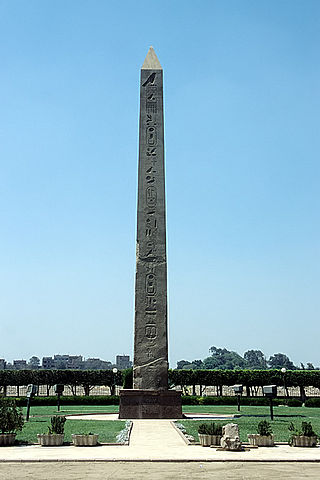
Heliopolis was a major city of ancient Egypt. It was the capital of the 13th or Heliopolite Nome of Lower Egypt and a major religious centre. It is now located in Ayn Shams, a northeastern district of Cairo.
An obelisk is a tall, four-sided, narrow tapering monument which ends in a pyramid-like shape or pyramidion at the top. Originally constructed by Ancient Egyptians and called tekhenu, the Greeks used the Greek term obeliskos to describe them, and this word passed into Latin and ultimately English. Though William Thomas used the term correctly in his Historie of Italie of 1549, by the late sixteenth century, Shakespeare failed to distinguish between pyramids and obelisks in his plays and sonnets. Ancient obelisks are monolithic and consist of a single stone; most modern obelisks are made of several stones.
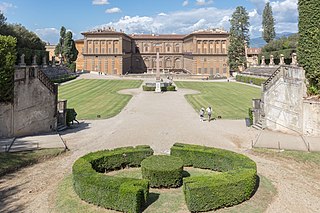
The Boboli Gardens is a historical park of the city of Florence that was opened to the public in 1766. Originally designed for the Medici, it represents one of the first and most important examples of the Italian garden, which later served as inspiration for many European courts. The large green area is a real open-air museum with statues of various styles and periods, ancient and Renaissance that are distributed throughout the garden. It also has large fountains and caves, among them the splendid Buontalenti grotto built by the artist, architect, and sculptor Bernardo Buontalenti between 1536 and 1608.

Niccolò di Raffaello di Niccolò dei Pericoli, called "Il Tribolo" was an Italian Mannerist artist in the service of Cosimo I de' Medici in his natal city of Florence.

The Pincian Hill is a hill in the northeast quadrant of the historical centre of Rome. The hill lies to the north of the Quirinal, overlooking the Campus Martius. It was outside the original boundaries of the ancient city of Rome, and was not one of the Seven hills of Rome, but it lies within the wall built by Roman Emperor Aurelian between 270 and 273.

Cleopatra's Needle in New York City is one of a pair of obelisks, together named Cleopatra's Needles, that were moved from the ruins of the Caesareum of Alexandria, Egypt, in the 19th century. The stele, dating from the 15th century B.C., was installed in Central Park, west of the Metropolitan Museum of Art's main building in Manhattan, on February 22, 1881. It was secured in May 1877 by judge Elbert E. Farman, the United States Consul General at Cairo, as a gift from the Khedive for the United States remaining a friendly neutral as two European powers, France and Britain, maneuvered for political control of the Egyptian government. The transportation costs were largely paid by a railroad magnate, William Henry Vanderbilt, the eldest son of Cornelius Vanderbilt.
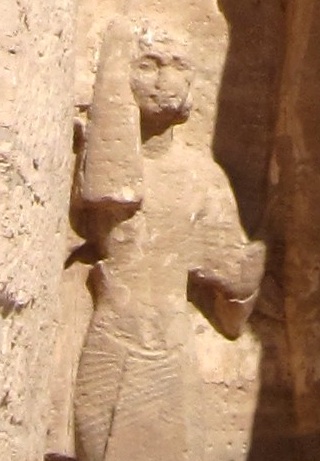
Meryatum was an ancient Egyptian prince and High Priest of Re, the son of Pharaoh Ramesses II and Queen Nefertari.

The Obelisk of Montecitorio, also known as Solare, is an ancient Egyptian, red granite obelisk of Psamtik II from Heliopolis. Brought to Rome with the Flaminio Obelisk in 10 BC by the Roman Emperor Augustus to be used as the gnomon of the Solarium Augusti, it is now in the Piazza Montecitorio. It is 21.79 metres (71 ft) high, and 33.97 metres (111 ft) including the base and the globe.
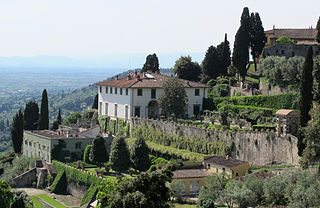
The Medici villas are a series of rural building complexes in Tuscany which were owned by members of the Medici family between the 15th century and the 17th century. The villas served several functions: they were the country palaces of the Medici, scattered over the territory that they ruled, demonstrating their power and wealth. They were also recreational resorts for the leisure and pleasure of their owners; and, more prosaically, they were the centre of agricultural activities on the surrounding estates. In 2013, the Medici villas were added to UNESCO's World Heritage list.

The Villa di Castello, near the hills bordering Florence, Tuscany, central Italy, was the country residence of Cosimo I de' Medici, Grand Duke of Tuscany (1519-1574). The gardens, filled with fountains, statuary, and a grotto, became famous throughout Europe. The villa also housed some of the great art treasures of Florence, including Sandro Botticelli's Renaissance masterpieces The Birth of Venus and Primavera. The gardens of the Villa had a profound influence upon the design of the Italian Renaissance garden and the later French formal garden.

El Matareya is a district in the Eastern Area of Cairo, Egypt. The district is unrelated to the coastal town in the Dakahlia Governorate, that is also named El Matareya. The district holds the ruins of the ancient Egyptian city of Heliopolis, one of the oldest cities of ancient Egypt.
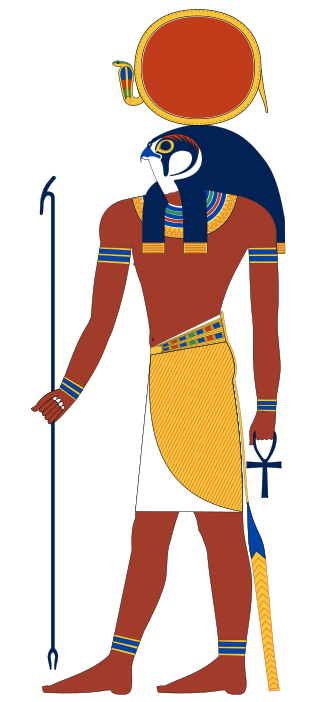
Ra or Re was the ancient Egyptian deity of the Sun. By the Fifth Dynasty, in the 25th and 24th centuries BC, he had become one of the most important gods in ancient Egyptian religion, identified primarily with the noon-day sun. Ra ruled in all parts of the created world: the sky, the Earth, and the underworld. He was believed to have ruled as the first pharaoh of Ancient Egypt. He was the god of the sun, order, kings and the sky.
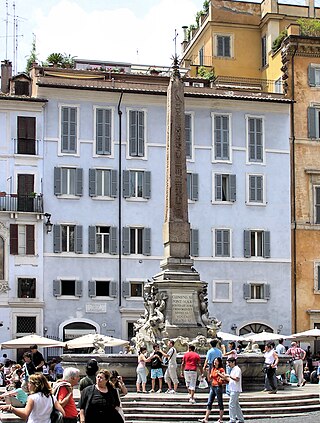
Piazza di San Macuto is a piazza in the Pigna rione of Rome. It contains the church of San Macuto, near which the obelisco Macuteo was rediscovered around 1373. This is a small obelisk, only 6.34 m high. It was originally one of a pair at Ramesses II's Temple of Ra in Heliopolis, the other being the now much shorter Obelisco Matteiano. It was moved from there to the Temple of Isis near Santa Maria sopra Minerva in antiquity, in what is now Piazza della Minerva and after its 14th century rediscovery was re-erected east of Santa Maria in Aracoeli on the Capitoline then in the Piazza della Rotonda in 1711.
The High Priest of Ra or of Re was known in Egyptian as the wr-mꜢw, which translates as Greatest of Seers.
The Flaminio Obelisk is one of the thirteen ancient obelisks in Rome, Italy. It is located in the Flaminio quarter on Piazza del Popolo.

The Baths of Nero or Baths of Alexander were a complex of ancient Roman baths on the Campus Martius in Rome, built by Nero in either 62 or 64 and rebuilt by Alexander Severus in 227 or 229. It stood between the Pantheon and the Stadium of Domitian and were listed among the most notable buildings in the city by Roman authors and became a much-frequented venue. These thermae were the second large public baths built in Rome, after the Baths of Agrippa, and it was probably the first "imperial-type" complex of baths, with a monumental scale and symmetrical, axially-planned design. While in the sixteenth century the foundations of the caldarium were still visible, nothing else of the structure remains above ground except some fragments of walls incorporated into the structure of Palazzo Madama.

The Temple of Isis and Serapis was a double temple in Rome dedicated to the Egyptian deities Isis and Serapis on the Campus Martius, directly to the east of the Saepta Julia. The temple to Isis, the Iseum Campense, stood across a plaza from the Serapeum dedicated to Serapis. The remains of the Temple of Serapis now lie under the church of Santo Stefano del Cacco, and the Temple of Isis lay north of it, just east of Santa Maria sopra Minerva. Both temples were made up of a combination of Egyptian and Hellenistic architectural styles. Much of the artwork decorating the temples used motifs evoking Egypt, and they contained several genuinely Egyptian objects, such as couples of obelisks in red or pink granite from Syene.

Cleopatra's Needle in London is one of a pair of obelisks, together named Cleopatra's Needles, that were moved from the ruins of the Caesareum of Alexandria, in Egypt, in the 19th century. Inscribed by Thutmose III and later Ramesses II of the Egyptian New Kingdom, the obelisk was moved in 12 BC to Alexandria, where it remained for over 1,800 years.
